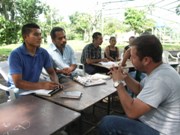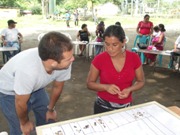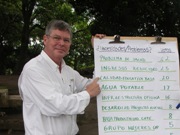Chapter 1. How-to: Community Needs Assessment
Chapter 1 Summary of my complementary, 50 page e-book: Four Powerful 1st Steps in Designing & Funding Non Profit Projects.
In the last newsletter we looked at how facilitating a needs assessment with your community can lead to a better understanding of client needs, their underlying causes, and can lead to long-term project sustainability. You can read that discussion here.
Different types of organizations will need to conduct needs assessments that range from very simple to highly sophisticated. I included a range of guides where you could select one that would be most appropriate for the level of sophistication needed for your organization.
The example in this newsletter is for a very simple needs assessment conducted by a food bank/pantry in Southern California. They used a participatory assessment technique called the Ten Seed Technique. They worked with a focus group of people who access the food bank—and who are also representative of the 2,500 people who access the food bank on an annual basis.
|
Participants were able to voice needs and challenges openly and freely.
|
|
 |
The focus group was able to voice concerns, challenges, problems, and need openly and freely. The facilitator wrote everything down on a large sheet of newsprint. When they had exhausted their concerns, she took a couple of minutes to write them out again more neatly.
|
| Participants were able to vote on the needs most important to them. | |
 |
She then handed out 10 pennies to each participant and asked them to go up individually and vote on the needs that they felt were the most important. They were able to put all 10 pennies adjacent to one challenge—or distribute their pennies across several challenges.
|
| Workshop facilitators drew up a prioritized list based upon the vote. | |
 |
At the end of the vote, she made a prioritized list of the needs with the need receiving the most votes at the top of the list.
She then opened up discussion with the participants to make sure that they were still okay with this prioritization. Everyone was in agreement.
|
She then did a capacity and assets assessment which was conducted in an open discussion. She asked them if they had any skills, time, materials, tools—or other resources that they might be able to contribute to a new project that would help address the challenges that they had identified in the needs assessment.
Participants voiced that they would be able to volunteer some time to the project—for example in organizing incoming food for distribution. The idea for vegetable gardens came up—and several participants mentioned that they had basic gardening tools and gardening knowledge that they would be willing to share with others.
Last, the facilitator then unraveled the mixture of needs and underlying causes that the community voiced and organized them into a simple problem tree which is the first step in creating a project outline which we will do next week.
You can download the assessment instructions and a finished example of the completed results of the assessment at the top of this page.
There is also a link to a video on how to turn your assessment results into a problem tree and problem statement.
Please note:
This is part of the process for facilitating a needs assessments for a course I teach called OL 201, Designing and Funding Nonprofit Projects. The first two assignments in 201 include detailed instructions for conducting a live needs assessment, specific resources that you will need for conducting the assessment, an example of a completed assessment, and a preliminary project concept based upon the results.
I hope that you enjoy this. If you have a question don’t hesitate to contact us.
Sincerely,
Tim Magee

